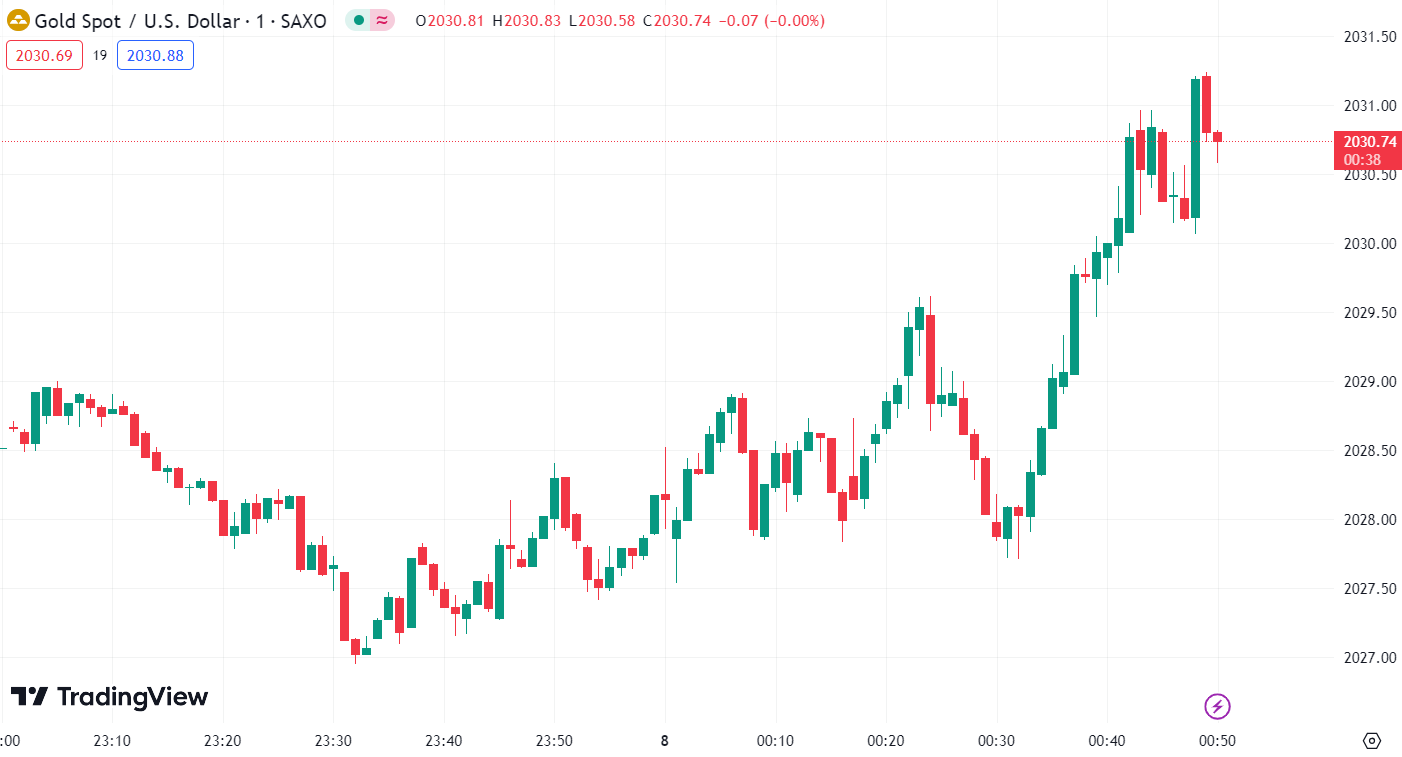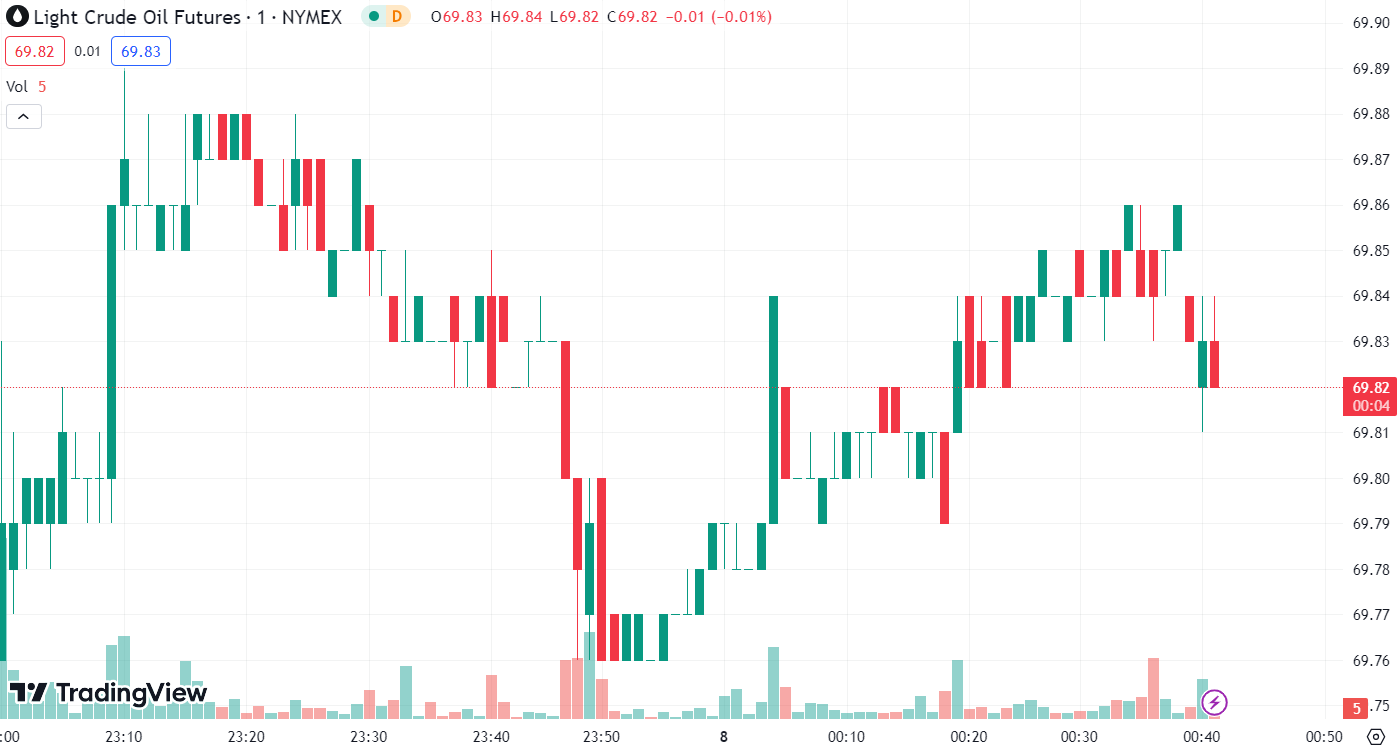
Before the release of the U.S. non-farm employment data, the market anticipated a weakening employment sector, causing the USD to weaken and boosting the price of gold.
The imbalance in supply and demand in the oil market intensified, leading to a continuous decline in oil prices, with the U.S. crude oil price falling below the USD 70 integer mark.
Gold >>
On Thursday, gold futures closed down 0.07%, at USD 2046.4 per ounce. Spot gold closed at USD 2028.49 per ounce, registering a slight increase of USD 3.19 or 0.16%. The intraday high reached USD 2039.94 per ounce, while the low touched USD 2020.15 per ounce.
Before the release of the U.S. non-farm employment data, the market anticipated a weakening employment sector, thereby increasing the possibility of the Federal Reserve cutting interest rates as early as March next year.
The weakening of the U.S. dollar boosted the price of gold, leading to an increase in spot gold. Data released by the U.S. Department of Labor on Thursday showed that for the week ending December 2nd, initial jobless claims increased by 1,000, seasonally adjusted to 220,000.
Due to holiday-related factors, initial jobless claims tend to fluctuate significantly at this time of year, making it difficult to obtain clear signals in the job market. Nevertheless, the market generally believes that the labor market is slowing down.
The market is now focused on the upcoming release of U.S. non-farm employment data to assess the potential policy path of the Federal Reserve. On the technical side, gold oscillated and closed at USD 2025 on the previous day, facing resistance at the USD 2035 level and support at the USD 2016 level.
In the Asian session, trading remained mostly sideways with a limited overall range. In the U.S. session, prices touched the intraday high before immediately falling back.
Technical Analysis:

Today’s short-term strategy for gold suggests prioritizing short positions during rebounds, with long positions considered as a secondary approach during pullbacks.
- Key resistance levels to watch in the short term are around 2040-2045.
- Key support levels to watch in the short term are around 2010-2015.
WTI Crude Oil >>
On Thursday, oil prices continued to decline, with U.S. crude oil futures falling by USD 0.04 per barrel to USD 69.34, a decrease of 0.31%. Brent crude oil futures also dropped by USD 0.25 per barrel to USD 74.05.
The two largest oil-exporting countries globally, Saudi Arabia and Russia, on Thursday called on all OPEC+ member countries to join production cut agreements to safeguard the interests of the global economy.
They stated that this move is in the interest of producers and the broader global economy. Concerns about crude oil demand from major Asian countries also limited the upward movement of oil prices.
Chinese customs data revealed a 9% year-on-year decrease in crude oil imports in November, attributed to high inventory levels, weak economic indicators, and a slowdown in orders from independent refineries.
Following the previous day’s drop to a six-month low, oil prices continued to decline on Thursday as investors remained concerned about subdued demand in the United States and China.
Traders believe that the market may experience oversupply, with Brent crude oil prices this month falling below the levels seen in the past six months. On the technical side, oil prices oscillated at low levels on the previous day, with consolidation and some rebound action.
However, they failed to rise above the vicinity of USD 74, ultimately falling back to around USD 70. In the Asian session, there was a slight uptick in the opening; during the European session, oil prices extended gains but did not sustain the bullish momentum seen in multiple previous declines.
Towards the U.S. session, prices touched intraday highs before immediately retracing, giving up the gains.
Technical Analysis:

Today’s crude oil trading strategy suggests prioritizing short positions during rebounds, with long positions considered as a secondary approach during pullbacks.
- Key resistance levels to monitor in the short term are around 70.7-71.2.
- Key support levels to monitor in the short term are around 69.0-68.5.
Forward-looking Statements
This article contains “forward-looking statements” and may be identified by the use of forward-looking terminology such as “anticipate”, “believe”, “continue”, “could”, “estimate”, “expect”, “hope”, “intend”, “may”, “might”, “plan”, “potential”, “predict”, “should”, or “will”, or other variations thereon or comparable terminology. However, the absence of such terminology does not mean that a statement is not forward-looking. In particular, statements about the expectations, beliefs, plans, objectives, assumptions, future events, or future performance of Doo Prime will be generally assumed as forward-looking statements.
Doo Prime has provided these forward-looking statements based on all current information available to Doo Prime and Doo Prime’s current expectations, assumptions, estimates, and projections. While Doo Prime believes these expectations, assumptions, estimations, and projections are reasonable, these forward-looking statements are only predictions and involve known and unknown risks and uncertainties, many of which are beyond Doo Prime’s control. Such risks and uncertainties may cause results, performance, or achievements materially different from those expressed or implied by the forward-looking statements.
Doo Prime does not provide any representation or warranty on the reliability, accuracy, or completeness of such statements. Doo Prime is not obliged to provide or release any updates or revisions to any forward-looking statements.
Disclaimer
While every effort has been made to ensure the accuracy of the information in this document, DOO Prime does not warrant or guarantee the accuracy, completeness or reliability of this information. DOO Prime does not accept responsibility for any losses or damages arising directly or indirectly, from the use of this document. The material contained in this document is provided solely for general information and educational purposes and is not and should not be construed as, an offer to buy or sell, or as a solicitation of an offer to buy or sell, securities, futures, options, bonds or any other relevant financial instruments or investments. Nothing in this document should be taken as making any recommendations or providing any investment or other advice with respect to the purchase, sale or other disposition of financial instruments, any related products or any other products, securities or investments. Trading involves risk and you are advised to exercise caution in relation to the report. Before making any investment decision, prospective investors should seek advice from their own financial advisers, take into account their individual financial needs and circumstances and carefully consider the risks associated with such investment decision.